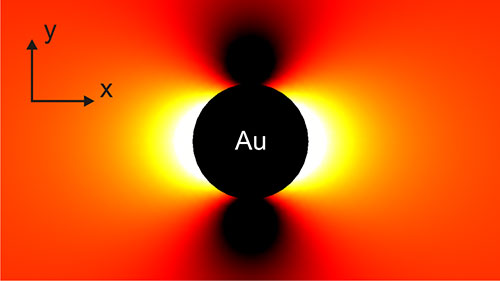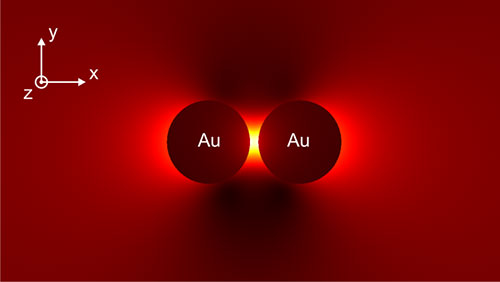Hot Spots
Localized Surface Plasmons
The surface plasmon phenomenon has been realized not only using planar metal surfaces, but also particles that are much smaller than the incident wavelength of light. In the latter case a surface plasmon resonance condition is automatically satisfied [1]. The plasmon mode is then known as a localized surface plasmon resonance (LSPR). For nanosized silver and gold, the LSPR falls into the visible range of the electromagnetic spectrum. Therefore, silver or gold nanoparticles can be directly observed using, for instance, the dark-field scattering microscopy.

In contrast to propagating SPPs, localized surface plasmons (LSPs) are non-propagating excitations of the conduction electrons. The LSPR enhance the local and scattered fields around the particle, which then can be utilized as a sensor, see Figure 1. As explained by Gustav Mie, the nanoparticle LSPR is sensitive to the index of refraction of the surrounding medium, and the change in this causes a change in the color of the nanoparticle.
Raman scattering (SERS) phenomenon
In this section we briefly discuss the so-called hot spots that contribute significantly to the surface-enhanced Raman scattering (SERS) phenomenon. From Figure 1, one can immediately see that by placing another gold particle next to it, the particle LSPRs should "work together" . Indeed, additional enhancement is expected due to the electromagnetic interaction between gold nanoparticles, see Figure 2.

Consider the simplest interaction case between two gold nanoparticles, i.e. two interacting dipoles.
The incident field induces two in-phase dipoles aligned along the direction of the incoming field. Simply put, the two dipole fields will strengthen each other if the E-field is polarized along the x-axis, and counteract if the E-field is polarized along the z-axis, i.e. these are so-called longitudinal and transverse collective modes, respectively.
If the particle separation is ![]() and particle diameter is
and particle diameter is ![]() , it can be shown that for
, it can be shown that for ![]() near-field interactions dominate and fall according to
near-field interactions dominate and fall according to ![]() . Therefore, in order to create extremely high field confinements (hot spots) it is important to produce very small interparticle gaps, i.e.
. Therefore, in order to create extremely high field confinements (hot spots) it is important to produce very small interparticle gaps, i.e. ![]() .
.
One should also keep in mind that this point dipole approximation underestimates particle interactions at close separations. However, the picture is still useful in providing some insight into the interaction phenomenon. Although particle dimmers create hot spots, the electric field intensity enhancement is generally quite low. In later paragraphs we introduce a SERS substrate (Serstrate) that displays extremely promising field confinement qualities in comparison to other commercially available metal nanostructures.